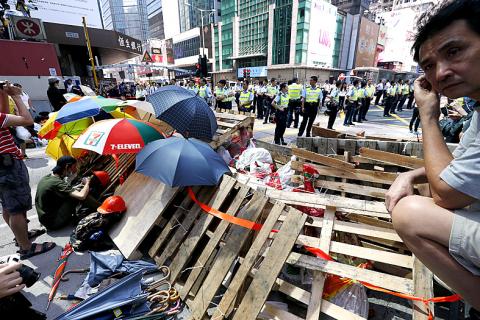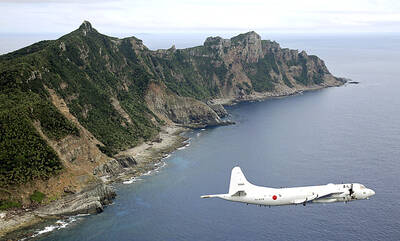Hong Kong pro-democracy activists recaptured parts of a core protest zone from police early yesterday after hours of turmoil that the city’s police chief warned undermined order and jeopardized public safety.
Dozens of people were injured, including 18 police, in the skirmishes that raged through the night as several thousand protesters squared off again police in the densely populated Mong Kok area.
At least 33 people were arrested, Hong Kong public broadcaster RTHK reported.

Photo: EPA
Police used batons and pepper spray, and scuffled violently with activists, but they were eventually forced to pull back less than 24 hours after they reopened most of the area to traffic.
The protests have been going on for three weeks and pose one of the biggest political challenges for China since the crushing of pro-democracy demonstrations in Beijing in 1989.
Hong Kong Police Commissioner Andy Tsang (曾偉雄) broke three weeks of public silence to say his force had been “extremely tolerant,” but had failed to stop protesters becoming more “radical or violent.”
“To these protesters: You may think that your illegal acts have prevented the police from going about our duties, disrupted our deployments and even forced us to retreat,” Tsang told a news conference. “Superficially, that may be the case, but let me tell you this: These illegal acts are undermining the rule of law, undermining [what] Hong Kong has been relying on to succeed.”
After police retreated, demonstrators swiftly stacked up barricades made out of packing crates and fences.
Tsang said the reoccupation of the area “seriously undermined public order and seriously jeopardized public safety.”
The protesters, led by a restive generation of students, have been demanding the Chinese Communist Party live up to constitutional promises to grant full democracy to the former British colony, which returned to Chinese rule in 1997.
Hong Kong is ruled under a “one country, two systems” formula that allows the thriving capitalist hub wide-ranging autonomy and freedoms and specifies universal suffrage for Hong Kong as an eventual goal.
However, Beijing ruled on Aug. 31 it would screen candidates who want to run for the city’s chief executive in 2017, which democracy activists said rendered the universal suffrage concept meaningless. The protesters are demanding free elections for their leader.
The clashes came just hours after pro-Beijing Hong Kong Chief Executive Leung Chun-ying (梁振英) offered talks to student leaders next week in an attempt to defuse the protests that have grabbed global headlines with scenes of clashes and tear gas rising between some of the world’s most valuable office buildings.
Hong Kong Chief Secretary Carrie Lam (林鄭月娥) yesterday announced that talks between student leaders and the city government would take place for two hours on Tuesday.
The Mong Kok area was calm later yesterday, with the number of protesters much smaller as activists rested.
Police stood in formation away from the barricades.
Posters declaring “Reclaim Mong Kok!” had been plastered on shop fronts.
The protesters who remained were bracing for another bruising night.
Student Angel So, 20, said she was determined to stop police clearing the area again.
“We’ll keep coming back,” she said, as a friend, Terry Leung, nursed grazes on his arms and legs from scuffles with police.
Joshua Wong (黃之鋒), a bookish 18-year-old whose fiery speeches have helped drive the protests, was defiant.
“We will stay and fight till the end,” he said as he surveyed the crowd during the night, from on top of a subway station exit.
The escalation in the confrontation illustrates the dilemma faced by police in trying to strike a balance between law enforcement and not inciting the protesters, who have been out since late last month in three core shopping and government districts.
Besides Mong Kok, about 1,000 protesters remained camped out on Hong Kong Island in a sea of tents on an eight-lane highway beneath skyscrapers close to government headquarters.
Despite Leung’s offer of talks next week, few expect any resolution without more concrete concessions from authorities.

MISINFORMATION: The generated content tends to adopt China’s official stance, such as ‘Taiwan is currently governed by the Chinese central government,’ the NSB said Five China-developed artificial intelligence (AI) language models exhibit cybersecurity risks and content biases, an inspection conducted by the National Security Bureau (NSB) showed. The five AI tools are: DeepSeek, Doubao (豆包), Yiyan (文心一言), Tongyi (通義千問) and Yuanbao (騰訊元寶), the bureau said, advising people to remain vigilant to protect personal data privacy and corporate business secrets. The NSB said it, in accordance with the National Intelligence Services Act (國家情報工作法), has reviewed international cybersecurity reports and intelligence, and coordinated with the Ministry of Justice Investigation Bureau and the National Police Agency’s Criminal Investigation Bureau to conduct an inspection of China-made AI language

LIMITS: While China increases military pressure on Taiwan and expands its use of cognitive warfare, it is unwilling to target tech supply chains, the report said US and Taiwan military officials have warned that the Chinese People’s Liberation Army (PLA) could implement a blockade within “a matter of hours” and need only “minimal conversion time” prior to an attack on Taiwan, a report released on Tuesday by the US Senate’s China Economic and Security Review Commission said. “While there is no indication that China is planning an imminent attack, the United States and its allies and partners can no longer assume that a Taiwan contingency is a distant possibility for which they would have ample time to prepare,” it said. The commission made the comments in its annual

‘TROUBLEMAKER’: Most countries believe that it is China — rather than Taiwan — that is undermining regional peace and stability with its coercive tactics, the president said China should restrain itself and refrain from being a troublemaker that sabotages peace and stability in the Indo-Pacific region, President William Lai (賴清德) said yesterday. Lai made the remarks after China Coast Guard vessels sailed into disputed waters off the Senkaku Islands — known as the Diaoyutai Islands (釣魚台) in Taiwan — following a remark Japanese Prime Minister Sanae Takaichi made regarding Taiwan. Takaichi during a parliamentary session on Nov. 7 said that a “Taiwan contingency” involving a Chinese naval blockade could qualify as a “survival-threatening situation” for Japan, and trigger Tokyo’s deployment of its military for defense. Asked about the escalating tensions

DISPUTE: A Chinese official prompted a formal protest from Tokyo by saying that ‘the dirty head that sticks itself out must be cut off,’ after Takaichi’s Taiwan remarks Four armed China Coast Guard vessels yesterday morning sailed through disputed waters controlled by Japan, amid a diplomatic spat following Japanese Prime Minister Sanae Takaichi’s comments on Taiwan. The four ships sailed around the Senkaku Islands — known as the Diaoyutai Islands (釣魚台) to Taiwan, and which Taiwan and China also claim — on Saturday before entering Japanese waters yesterday and left, the Japan Coast Guard said. The China Coast Guard said in a statement that it carried out a “rights enforcement patrol” through the waters and that it was a lawful operation. As of the end of last month,